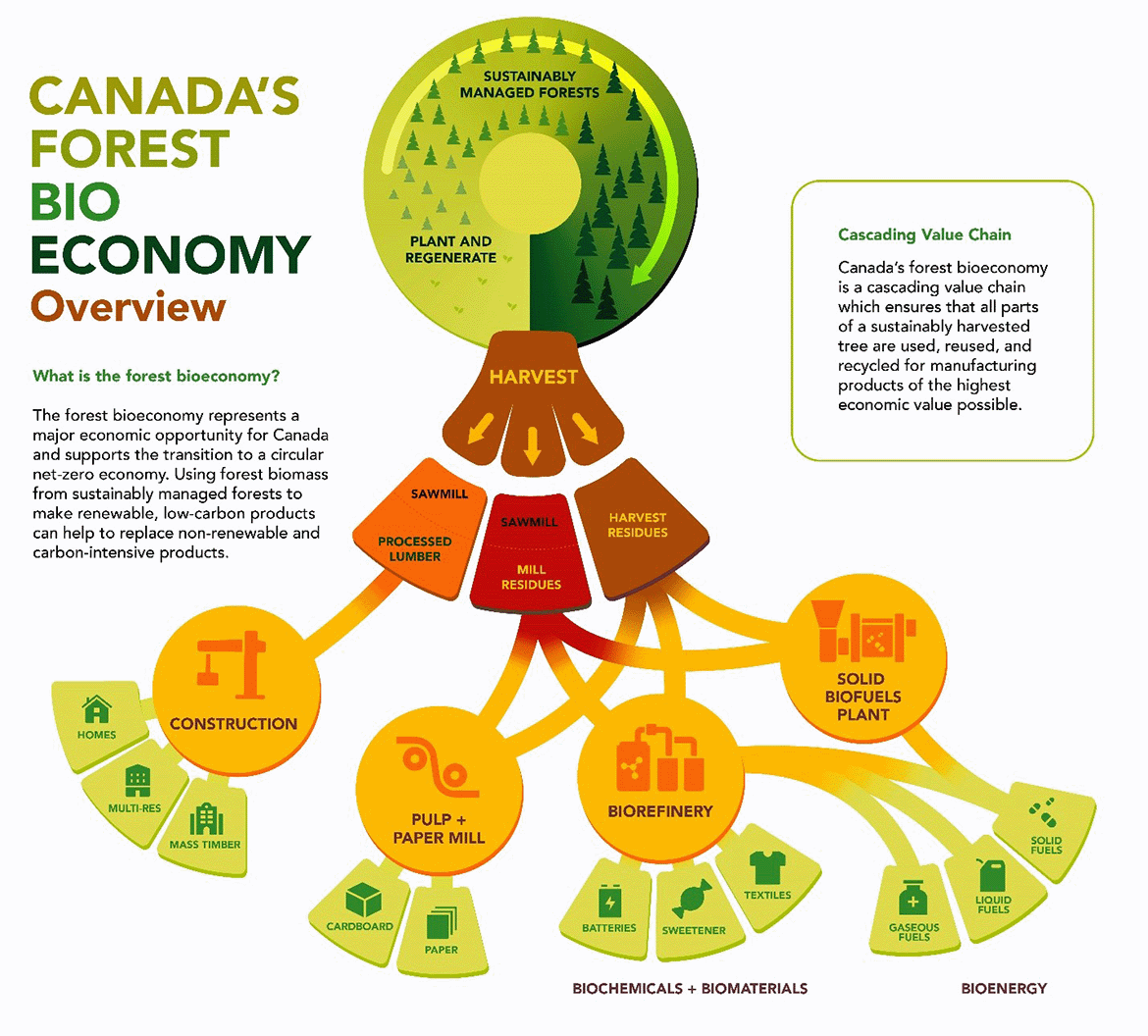The forest bioeconomy uses organic material derived from forests, namely logs but also residues coming from forest harvest operations and industrial processing, to make a range of bioproducts, including:
- lumber
- paper
- renewable fuels
- plastics
- pharmaceuticals
- adhesives
- lubricants
- electronics
By using innovative mechanical, thermal, chemical, biological and circular processes to manufacture an array of products, the forest bioeconomy ensures that any forest biomass harvested from Canada's forests is used efficiently.

Text version
Canada's forest bioeconomy overview
This image illustrates Canada’s forest bioeconomy value chain from sustainable forest management to end-products. The image begins with sustainably managed forests at the top followed by harvesting activities on the level below. On the left of the graphic, harvested wood is sent to sawmills to manufacture lumber, which is used in construction for buildings such as homes, multi-residential buildings, and Mass Timber buildings. In the center and the right side of the graphic, sawmill residuals (e.g., sawdust, wood chips, bark) and harvesting residues (e.g., treetops, branches) are sent to pulp and paper mills, biorefineries, and/or solid biofuels plants. Pulp and paper mills manufacture products such as cardboard and paper, while biorefineries manufacture an array of products including batteries, sweeteners, textiles, and gaseous, liquid and solid biofuels. Finally, solid biofuels plants manufacture solid biofuels (e.g.: wood pellets, wood chips).
This image also includes two small captions summarizing the forest bioeconomy and cascading value chain, which read:
What is the forest bioeconomy? The forest bioeconomy represents a major economic opportunity for Canada and supports the transition to a circular net-zero economy. Using forest biomass from sustainably managed forests to make renewable, low-carbon products can help to replace non-renewable and carbon-intensive products.
Cascading Value Chain: Canada’s forest bioeconomy is a cascading value chain which ensures that all parts of a sustainably harvested tree are used, reused, and recycled for manufacturing products of the highest economic value possible.
Forest bioeconomy and Canada
With 347 million hectares of forests accounting for 9% of the world’s forests, Canada is home to the most biomass per capita in the world. Of this, 72% is crown forest land that is certified to internationally recognized third party standards for sustainable forest management.
Using forest biomass from sustainably managed forests to make renewable and low-carbon products can help to replace non-renewable and carbon-intensive products. This supports the transition to a net-zero economy while providing new opportunities for Canada’s forest sector and forest-based communities.
For example, wood-based construction materials, such as lumber and Mass Timber, can store carbon for long periods of time, and renewable fuels, like sustainable aviation fuel, can be up to 80% less carbon intensive than petroleum-based fuels.
Many of these products are also compostable or can be recycled and reused, improving their overall sustainability, and reducing emissions from waste. This ensures that all the parts of a harvested tree are used for their highest value, from the branches and treetops to sawdust and woodchips from forest product manufacturing, to make consumer goods. This further supports climate change mitigation, biodiversity and conservation by doing more with less - leaving more trees in the forest while producing renewable low-carbon products for the future.
Demand for products like renewable low-carbon fuels, chemicals and materials is growing rapidly worldwide with the global circular bioeconomy projected to be worth up to $7.7 trillion USD by 2030. This presents a significant economic opportunity to support the growth, diversification, and competitiveness of Canada’s forest sector and forest-based communities, while supporting the transition to a circular net-zero economy.
Forest bioeconomy and communities
Canada’s forest bioeconomy also supports communities across Canada with one third of Canadians, and more than half of Indigenous peoples, living in or near forests. For example, the forest bioeconomy provides opportunities for Indigenous and community-led sustainable forest management that supports socioeconomic and sociocultural activities such as as hunting, camping, hiking, fishing, trapping and foraging for traditional food and medicines.
This builds strong, resilient, and self-sufficient communities, while also supporting their transition to a net-zero economy.
Forest bioeconomy in the future
Canada supports the forest sector and forest-based communities through several funding opportunities to diversify forest products, markets and processes that establish a competitive advantage for Canada’s forest sector.
For more information on what the forest bioeconomy means for Canada, visit Canada’s forest bioeconomy opportunities webpage.